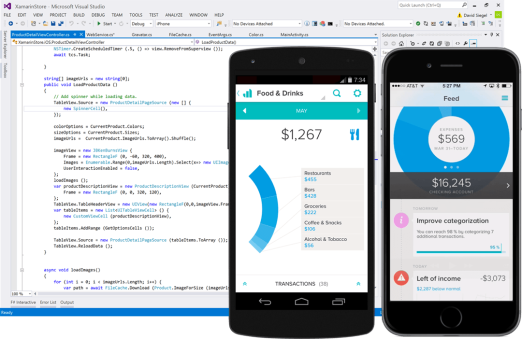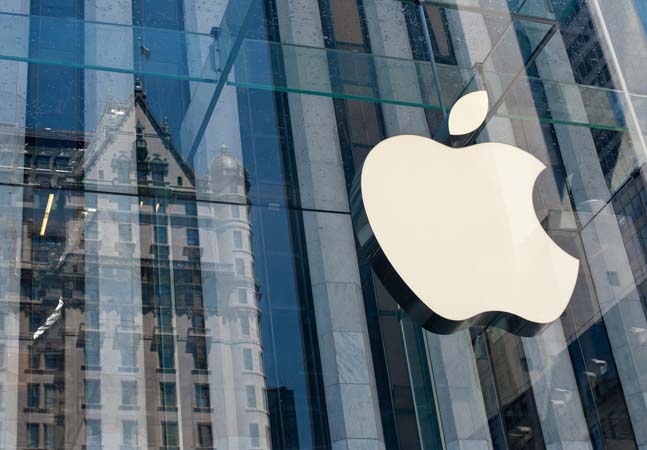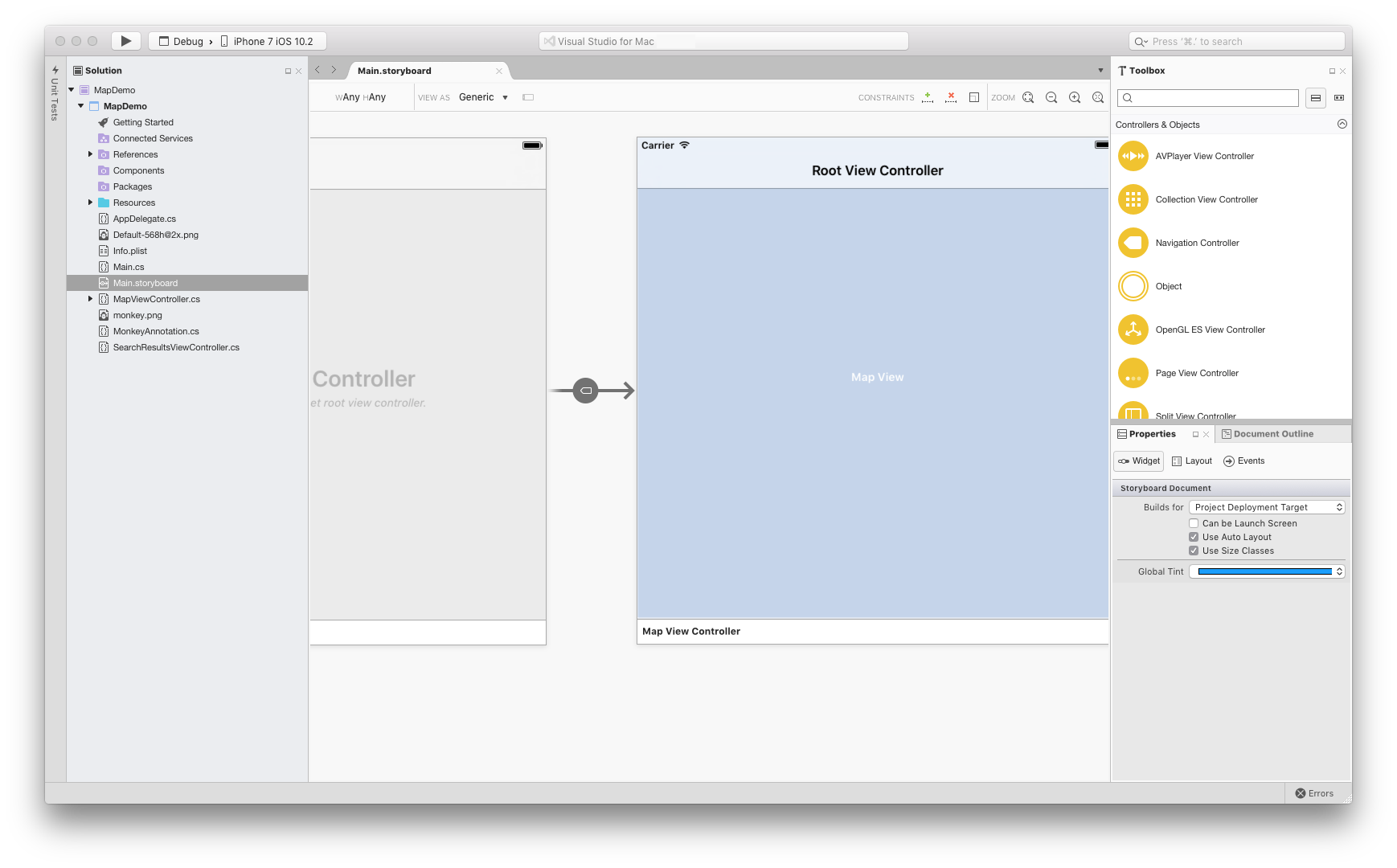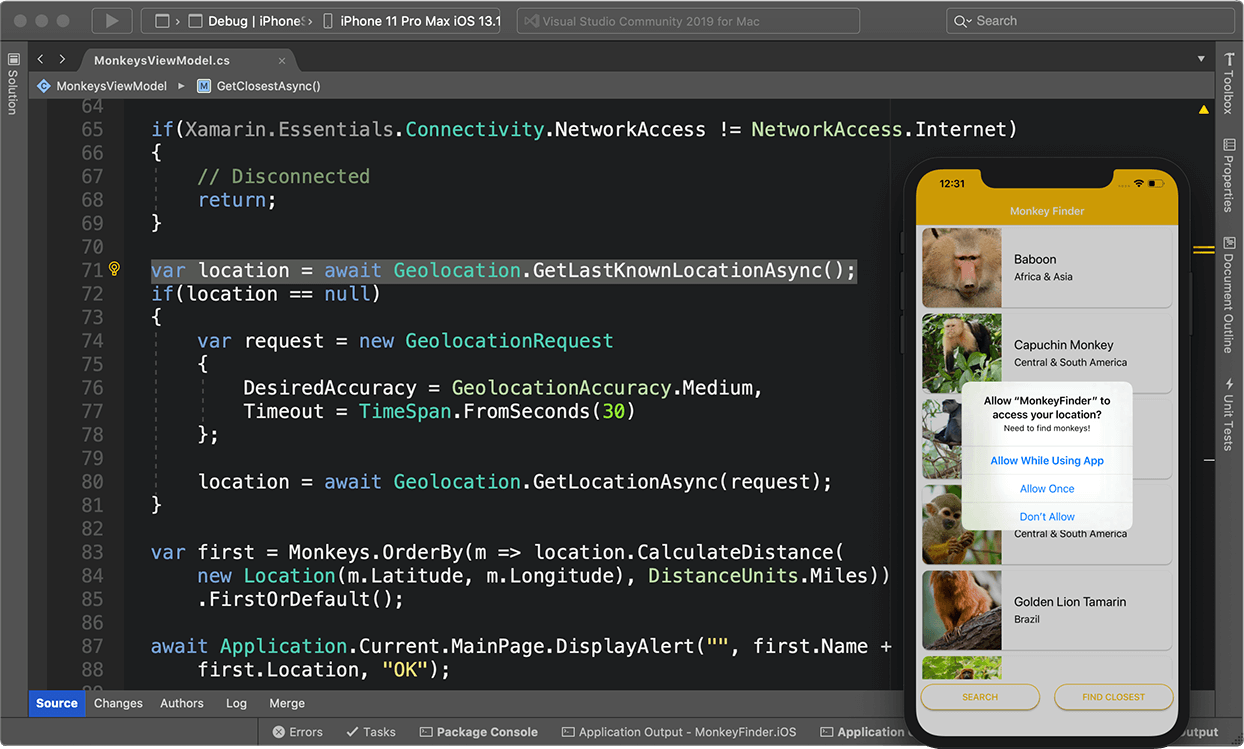Download Visual Studio Community, Professional, and Enterprise. Try Visual Studio IDE, Code or Mac for free today. Question on Xamarin Mac Forum - I asked the same question on the Xamarin Mac forum and it seems that you currently cannot build for Mac from Visual Studio. You're stuck with using Xamarin Studio. There were some alternative's but nothing official and not having resharper for it is pretty lame – Viv Jul 15 '13 at 15:35. Visual Studio for Mac has all the features of Xamarin Studio, and much more! You can now delete the Xamarin Studio app from your machine. I've been a VS developer for years on Windows and still use it for server-side development. In Visual Studio for Mac visual studio for mac xamarin ios Fixed - Pending Release. Nick Wallbridge (admin commented Jul 29, '20 21 Votes. Vs2017 for Mac Setup doesn't work, UI shows rectangles/boxes instead of text in Visual Studio for Mac visual studio for.
You can use this guide to uninstall each component in Visual Studio for Mac individually by navigating to the relevant section, or you can use the scripts provided in the Uninstall Script section to uninstall everything.
Note
This information will only remove Visual Studio 2019 or 2017 for Mac from your machine. to uninstall Visual Studio Code, see this issue for details.
Uninstall Script
There are two scripts that can be used to uninstall Visual Studio for Mac and all components for your machine:
The following sections provide information on downloading and using the scripts.
Download FL Studio Producer Edition 20.0.3.32 for Mac full version program setup free. Fl studio 10 producer edition free download. FL Studio Producer Edition 20.0.3.32 for Mac is a professional program specially used composing, arranging, recording, editing, mixing and mastering the professional quality music. FL Studio Producer Edition 20.0.3.32 for Mac ReviewFL Studio Producer Edition 20.0.3.32 for macOS is a popular sound editing program for producing quality sounds.
Visual Studio for Mac and Xamarin script
You can uninstall Visual Studio and Xamarin components in one go by using the uninstall script.
This uninstall script contains most of the commands that you will find in the article. There are three main omissions from the script and are not included due to possible external dependencies. To remove this, jump to the relevant section below and remove them manually:
To run the script, do the following steps:
Right-click on the script and select Save As to save the file on your Mac.
Open Terminal and change the working directory to where the script was downloaded:
Make the script executable and the run it with sudo:
Finally, delete the uninstall script and remove Visual Studio for Mac from the dock (if it's there).
.NET Core script
The uninstall script for .NET Core is located in the dotnet cli repo
To run the script, do the following steps:
Right-click on the script and select Save As Microsoft office for mac 2011 sp4. to save the file on your Mac.
Open Terminal and change the working directory to where the script was downloaded:
Make the script executable and the run it with sudo:
Finally, delete the .NET Core uninstall script.
Uninstall Visual Studio for Mac
The first step in uninstalling Visual Studio from a Mac is to locate Visual Studio.app in the /Applications directory and drag it to the Trash Can. Alternatively, right-click and select Move to Trash as illustrated in the following image:
Deleting this app bundle removes Visual Studio for Mac, even though there may be other files related to Xamarin still on the file system.
To remove all traces of Visual Studio for Mac, run the following commands in Terminal:
You may also want to remove the following directory containing various Xamarin files and folders. However, before you do you should be aware that this directory contains the Android signing keys. For more information refer to the section Uninstalling Android SDK and Java SDK:
Uninstall Mono SDK (MDK)
Mono is an open-source implementation of Microsoft's .NET Framework and is used by all Xamarin Products—Xamarin.iOS, Xamarin.Android, and Xamarin.Mac to allow development of these platforms in C#.
Warning
There are other applications outside of Visual Studio for Mac that also use Mono, such as Unity.Be sure that there are no other dependencies on Mono before uninstalling it.
To remove the Mono Framework from a machine, run the following commands in Terminal:
Uninstall Xamarin.Android
There are a number of items required for the installation and use of Xamarin.Android, such as the Android SDK and Java SDK.
Use the following commands to remove Xamarin.Android:
Uninstall Android SDK and Java SDK
The Android SDK is required for development of Android applications. To completely remove all parts of the Android SDK, locate the file at ~/Library/Developer/Xamarin/ and move it to Trash.
Warning
You should be aware that Android signing keys that are generated by Visual Studio for Mac are located in ~/Library/Developer/Xamarin/Keystore. Make sure to back these up appropriately, or avoid removing this directory if you wish to keep your keystore.
The Java SDK (JDK) does not need to be uninstalled, as it is already pre-packaged as part of Mac OS X / macOS.
Uninstall Android AVD
Warning
There are other applications outside of Visual Studio for Mac that also use Android AVD and these additional android components, such as Android Studio.Removing this directory may cause projects to break in Android Studio.
To remove any Android AVDs and additional Android components use the following command:
To remove only the Android AVDs use the following command:
Uninstall Xamarin.iOS
Xamarin.iOS allows iOS application development using C# or F# with Visual Studio for Mac.
Use the following commands in Terminal to remove all Xamarin.iOS files from a file system:

Uninstall Xamarin.Mac
Xamarin.Mac can be removed from your machine using the following two commands to eradicate the product and license from your Mac respectively:
Uninstall Workbooks and Inspector
Starting with 1.2.2, Xamarin Workbooks & Inspector can be uninstalled from a terminal by running:
For older versions, you need to manually remove the following artifacts:
- Delete the Workbooks app at
'/Applications/Xamarin Workbooks.app' - Delete the Inspector app at
'Applications/Xamarin Inspector.app' - Delete the add-ins:
'~/Library/Application Support/XamarinStudio-6.0/LocalInstall/Addins/Xamarin.Interactive'and'~/Library/Application Support/XamarinStudio-6.0/LocalInstall/Addins/Xamarin.Inspector' - Delete Inspector and supporting files here:
/Library/Frameworks/Xamarin.Interactive.frameworkand/Library/Frameworks/Xamarin.Inspector.framework
Uninstall the Xamarin Profiler
Uninstall the Visual Studio Installer

Xamarin For Vs 2015
Use the following commands to remove all traces of the Xamarin Universal Installer:
Uninstall Visual Studio 2019 for Mac Preview
Visual Studio 2019 for Mac Preview was launched as a separate preview, allowing you to continue to work with your Visual Studio 2017 for Mac install side-by-side.
Now that Visual Studio 2019 for Mac has been released, you can now safely remove the Visual Studio 2019 for Mac Preview application.
To uninstall the preview application bundle, select Visual Studio (Preview) from your Applications folder and click Move to Trash, as depicted in the following image:
You can also remove the Preview plist file with the following command:
See also
Back in .NET Conf 2017 The Xamarin team already shared what’s going to be new with Xamarin Forms 3.0 and it actually surprised me. I was expecting some performance improvements, bug fixing and a big upgrade on XAML. But, what they announced focuses on enabling the usage of Xamarin.Forms in more ways and on more platforms. I was really hoping for XAML improvements, maybe add some cascading styling like how CSS works. Maybe sometime in the future, we’ll get it. For now, I’ll just use the XAMLCss by warapa. Anyway if you want to watch all sessions from .NET Conf 2017, you can check it out on Channel9. Going back, I really didn’t expect these new features, but definitely, I love it and really excited to try it out!

That’s why right now, I’m going to show to you one of the exciting features added to the Xamarin.Forms 3.0 that I think you’ll also love. I’m talking about Xamarin.Form’s macOS support.

One of the Xamarin team’s plan is to reach more platforms. That means UWP, iOS and Android are not only platform the Xamarin.Forms will be able to target from now on, they are also bringing macOS, GTK#, Linux and WPF!
You might think that it will be hard and will take a lot of time to integrate your Xamarin.Forms solution into the macOS project, but it’s not. Not at all. You’ll be able to create a native macOS application using your Xamarin.Forms solution using Visual Studio for Mac or Xamarin Studio in just 3 quick steps!
First step: Add a Cocoa App project
Right now, Xamarin.Forms template doesn’t have a Cocoa App initially. So, what you would do is to start Visual Studio for Mac or Xamarin Studio and open your existing Xamarin.Forms solution. Then, add a project into the solution by right-clicking the solution and selecting Add > Add New Existing Project.
You can then select Mac > App > Cocoa App and name it whatever you want, but ideally, the name has a suffix of .macOs.
Second Step: Add the Xamarin.Forms NuGet Package
You will have to add the Xamarin.Forms’ latest pre-release nuget package or specifically 2.4.0.282. To do this, right click the Cocoa App project that you just created and select Add > Add Nuget Packages.
Then, search for ‘Xamarin.Forms’ and make sure that the ‘Show pre-release packages’ is ticked. Click ‘Add’ to add Xamarin.Forms nuget package.
You will also need to update the Xamarin.Forms on your shared project and the version should be the same with what the Cocoa app have.
Third Step: Configure the Cocoa App Project
The first thing that you should do with your Cocoa app project is to add the shared project into your Cocoa app as a reference.
Xamarin Studio For Windows

Then, open the Info.plist and remove the ‘Main storyboard file base name’ entry (Opened with XCode)
Visual Studio 2017 Xamarin Forms
Or just open the Info.plist inside Visual Studio or Xamarin Studio by clicking it and leave the Main Interface blank.
The next one is to update your Main.cs’ Main method to initialize the AppDelegate:
Lastly, update the AppDelegate by changing the NSApplicationDelegate to FormsApplicationDelegate:
Initialize the Cocoa app window within the constructor:
Then inside the DidFinishLaunching method, initialize Xamarin.Forms and load the application:
You can now set your project as the startup project and run your macOS!
Again, in just 3 quick steps, it’s done!
This is just a basic walkthrough since this is still on preview. Expect that there are still bugs and not ready for production. Not all nuget packages are compatible and surely, there are lots of UI features still not implemented, but this is a good start. For now, you can send your issues and problems that you encounter in this forum discussion: https://forums.xamarin.com/discussion/93585/preview-xamarin-forms-for-macos/p1 Open rar files mac free.